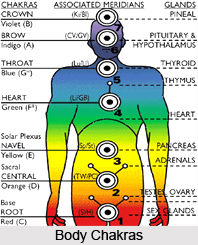 The mental body is indeed an important part. To understand the slightest mental vibration this body is needed. Proper exercises are needed for the overall stimulation of this body, which ultimately supports in developing the chakras too.
The mental body is indeed an important part. To understand the slightest mental vibration this body is needed. Proper exercises are needed for the overall stimulation of this body, which ultimately supports in developing the chakras too.
1.Mental Body-Physical Level- Lower throat just above the horseshoe
This chakra is very significant because it concerns accommodating what is and coordinating ways to work with it. It can liberate much power. Accepting does not mean one has to like it or bear it, rather, one needs to acknowledge and admit that something is the way it is; One then gains the power to orchestrate and do something with it. It is advised to take deep, peaceful breaths. One must open oneself in that chakra as much as possible. It can be questioned what two areas in life one needs to acknowledge and work with more. Questions can also be asked for ideas on how to do it. It needs to be questioned on what are the two areas in which one is performing quite well and can stop plaguing oneself about.
2. Mental Body-Emotional Level- The temples
This area concerns about how one feels about what one generally views. One can tense up and cause deformation in their vision, so one views only what own wants to or what one thinks one can manage. The temples need to be massaged gently. The energy must be allowed to flow and the consciousness of the temples can be asked what it has blocked, because one does not wish to see it. It can also be asked what can one do to see things with more simplicity and profundity.
3. Mental Body-Mental Level- Third eye between the eyebrows
This eye is linked with the ego and stimulates a sense of the human self. This eye needs to be asked in what area does one lets too much ego to cloud one`s vision; also one can ask where one is doing good.
4. Mental Body-Intuitional/Compassionate Level- The centre of the transverse colon, about midway between the navel and solar plexus chakra
This chakra relates to understanding one`s thoughts. One can question about what does one feel about the true approaches toward life. This might be another "hassle" chakra; due to unintegrated thought forms or unassimilated ideas, it might lead to impairment. Some energy needs to be sent to the chakra to open up and ask to know three areas in life in which one needs to be more compassionate toward one`s own thoughts and ideas.
5. Mental Body-Will/Spirit Level- Upper throat, straight back under the chin and under the base of the tongue
This chakra is related to articulation of thought and speaking up. If hindered, it might cause a deficiency of confidence in mental capabilities, clogging in words, an aching throat, loss of transparency or freedom in speech. The chakra needs to be massaged in this case. Later, one needs to ponder over what areas of life are complicated to talk about for oneself; what areas are open.
6. Mental Body-Soul Level- Fifth eye (centre of forehead)
The soul level of the mental body triggers the elevated mind and grants one to see the greater picture. Without adequate openness in it, one will not even realise that there are areas of knowledge outside the reach one`s knowing. When this chakra is closed, one may feel as if one knows it all, but is quite oblivious. The fifth eye needs to massaged. The energy must be allowed to flow out. It is advised to ask oneself where one is performing well to expand one`s grasp of the greater picture and where one is holding back.
7. Mental Body/Divine Level- Seventh eye (about 3/4-1 inch above the normal hairline or about 1-V/4 inch from the sixth eye
By moving one`s finger gently in this area, one may feel the chakra. After massaging the area, one needs to ask themselves to see a white light from the spiritual level. If light comes in a grimy or dark colour instead, one must understand that one either needs to develop this chakra more, or else go through more purification. The white light from the seventh eye (whether one sees it or feels it) must be allowed to come down and go out the third eye to bathe and uplift the go; then, one must feel those energies all over the body.




















